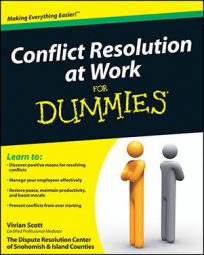When you're in a conflict-resolution meeting being held between an employee and yourself, you’ll wear two hats, that of mediator and that of contributor. Granted, you’re not acting as an objective third party in this instance, but coming prepared with an understanding of the mediation process gives you an opportunity to step back a bit and make room for both perspectives while following a structured and proven method.
Recognizing your dual role
Your task is complicated because you occupy two distinct roles at the same time, and one shouldn’t overshadow the other. In mediation, all parties have the right to ask for what they want, and by keeping the focus of the meeting on both your needs, you reinforce that goal. In other words, by staying true to the role of the facilitator, you reinforce your role as a participant.
Facilitator: Your responsibility is to use the process for both your benefit and the other person’s benefit, not just your own.
Participant: You have a right to speak your mind and ask that your needs be met, because this meeting is as much an opportunity for you to ask for what you want as it is for him.
Adapting a mediation process for a one-on-one meeting
Use your own words and be yourself during the meeting to discuss the conflict between you and your colleague. Have a plan, though, or the meeting probably won’t result in the outcome you had hoped for. You are required to balance your needs with the needs of your co-worker.
Follow these steps for a productive conversation:
Sincerely greet the other person and briefly acknowledge the conflict and the impact it’s had on you.
Explain that you’ll be following a mediation process (because you think the method will help you both focus) but that you’re just as much a participant as he is.
State your goal for a positive, respectful meeting, and that you both should consider this a time to confidentially present your views.
Ask the other person to share the events and the impact that the situation has had on him.
Reflect what you’ve heard, neutralize emotions, and spotlight values.
Share your perspective and ask your co-worker to reflect back to you what you’ve presented.
Build an agenda of topics for the ensuing conversation.
Collectively address any misunderstandings or assumptions.
Brainstorm solutions.
Filter through ideas to find those that best meet what’s most important to both of you.
Finalize agreements, paying special attention to details and what to do if things don’t work.
Share with others any details and results of your discussion only as necessary and appropriate.

